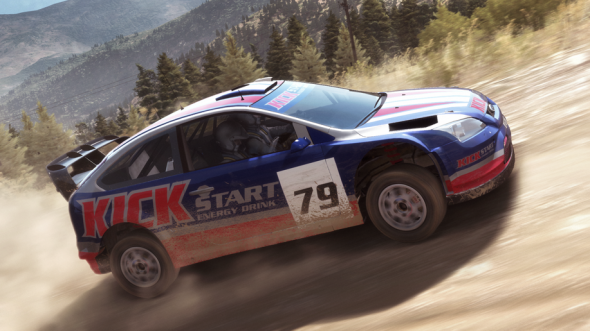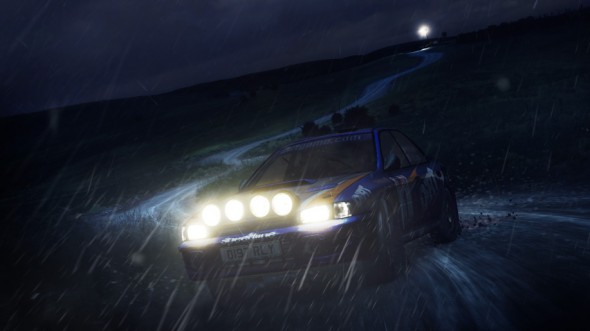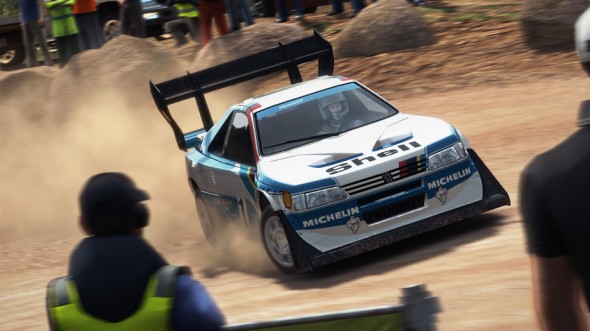Reviews
DiRT Rally
April 25, 2016, Author: James Swinbanks
It’s almost nine years since Codemasters introduced the DiRT name with the fantastic Colin McRae: DiRT, a game that is remembered well for two reasons. One is that it was both ambitious and enjoyable and set a new bar for rally titles, the other is its release the day before a tragic helicopter accident took the life of Colin McRae, his son and two others.
Since then, Codemasters had not only dropped the use of the Colin McRae name but switched focus from the traditional style of rally entirely. The results were DiRT 2, 3 and DiRT Showdown. These three games, whilst really good in their own right, all had a general focus on the less traditional forms of off-road racing like Gymkhana and Rallycross. They included point-to-point stages, but they were short and typically low in numbers. As a bit of a purist when it comes to a few facets of motorsport, I enjoyed the last few DiRT games to an extent but always felt like Codemasters had lost their way just a little.
Fast forward to a year ago and you can colour me, as just about everyone else, surprised when a Codemasters title named DiRT Rally popped up on Steam Early Access. It was the first case I could remember of a large AAA developer using Steam’s Early Access as a platform for an already established franchise, and I had to jump in on it. I bought into it, and as the months rolled by I watched as the game slowly had content and features added, as well as how engaged the developers were with the community about their development plans going forward. Not only this, but they seemed to be heading in a very good direction. More focus on point-to-point rallying, with long and open stages, as well as Hillclimb, Rallycross and a host of online features. Throw in a focus on simulating real-world handling techniques and vehicle dynamics, and DiRT Rally showed more promise on this front than we’d seen from the previous DiRT titles combined.
It was only a few short months ago in December that DiRT Rally was released properly on the PC, so the wait for it to head to the modern generation consoles hasn’t been a tense nor long one. After spending hours sliding, rolling, spinning and crashing as many rally cars as possible, it’s easy for me to tell you that whilst DiRT Rally redefines console rally games – once again cementing Codemasters’ position at the top of the racing development pyramid – its brilliance shines heavily on the areas it falls short, holding it back from being something truly special.
DiRT Rally is all about your career as a rally driver with your team. At the beginning of your career you select a crew chief, someone that will act as the lead technician for your team throughout. The crew chief’s skill level will define your team’s overall rating, which will increase as you begin to add other mechanics. Team rating doesn’t mean a whole lot in the grand scheme of things. It’s more an indicator of your team’s overall ability to do two things: upgrade and repair the car. The more experience you have with your team members overall, the more events you can take part in together and the higher their ratings can get, also unlocks the ability to apply perks. Perks are hardly as exciting as they sound, as they mostly apply to very slightly speeding up the research of specific car upgrades. It’s not a hugely appealing reward and as a result, they feel like a bit of a pointless inclusion.

79 Duuuude.
Unlike perks, the actual car upgrade system – that applies bonuses like increased engine power or reduced weight – is good, if a little automated. The only input required from the player is to drive. The more distance you cover, the more upgrades that will be applied to that current car. Each car seems to have anywhere between 2-4 upgrades that can be applied, and you don’t get any choice in the matter regarding which ones. It’s all decided by the game itself, which is fine for those who like to arrive and drive, but I would’ve liked to have seen a little wiggle room here to make those kinds of decisions. If I’m in a car that I know is under-powered compared to the competition, I’d like to be able to choose an engine upgrade before a weight reduction upgrade.
If you’re a bit like me and not afraid to tweak the setup on the car to improve the feel, probably the most useful upgrade you can get is unlocking the ability to apply an advanced setup. By default, you can play with a few basic setup sliders like softer or harder springs, or brake bias settings. When you unlock the advanced setup, each of those sliders then opens up into a sub menu of even more sliders. For example, if you go to change the front springs, instead of just changing a springs slider, there will be ride height, camber and toe settings, and a few others. It’s intimidating and utterly useless if you don’t know what you’re doing. There are some tooltips that alleviate some of the confusion, but this touch is more for the hardcore crowd instead of the couch racer.
Which brings me to the driving. Codemasters have elected to move away from the floaty, super-responsive characteristics of the last few DiRT games in favour of a more simulation-based route instead. It’s a change so significant that Codemasters themselves feel the need to warn you of it at the very beginning of the game. “You will need to utilize real world driving techniques…” it warns. Ignoring the obvious hyperbole, DiRT Rally does indeed require some knowledge of how to drive a car quickly in order to win events.
Each style of event is considerably different, despite sharing the same core concept – driving off-road at speeds too ludicrous to consider them sane. Rally consists of your standard point-to-point events that take place on a variety of track surfaces including snow, gravel, mud and tarmac. Drivers are joined by a co-driver, who reads out the pace notes to let you know what sort of corner you are approaching. Hillclimb is similar, except that it takes place at one location only, the world famous Pikes Peak in the USA. This special kind of point-to-point event uses insanely overpowered cars without the aid of a co-driver, so the margin for error is even smaller than usual. Rallycross is a more direct race around a short circuit against other cars. There are heats which lead into a semi-final and then a final race to determine the winner of the event. Each circuit has what’s called a ‘joker’, a separate section of track that drivers must navigate at least once in a race otherwise they’ll be disqualified.

Well, this looks safe. It’s fine. Probably…
Each event uses a different type of car, and as such, handling characteristics of each car are remarkably different, as they should be given the huge mix of what’s on offer. Rallying uses anything from 1960’s kit cars through to the modern day, four-wheel drive rocket ships seen in the current World Rally Championship. A rear-wheel drive Group B car drives very differently to one of the Hillclimb or Rallycross cars; you can easily feel the difference in both the level of power and how that power is applied to the road, and as a result you need to be able to adapt your driving style to suit.
You will make plenty of mistakes along the way, and DiRT Rally can seem a little punishing at first. The reality is that the lack of a rewind feature – something that Codemasters first pioneered in its GRID series – will hurt plenty of newcomers. In fairness, it is no more punishing than Rally racing can be in real life. Hurtling across dirt and icy roads with ditches, rocks, trees or cliffs either side, you are never more than a few inches from tragedy. Never did I feel this more palpably than when I made a mistake which sent me barrelling towards a mob of spectators – the game mercifully fading to black before entering Carmageddon territory and placing my car back on the track, albeit with a 15-second time penalty applied.
You aren’t ever given a moment to relax and take in the gorgeous surroundings. Have I even mentioned yet that the game is absolutely stunning? The first time I watched a replay of a decent, error-free run, I was gobsmacked by the detail up close, as well as the wider scope of the stages themselves. Draw distances are massive, which is great because the picturesque surroundings have always been a part of the spectacle of rally. Of the point-to-point stages, most are around five or so kilometres in length. Some of the longer stages are twice that in length.
There is a level of monotony in some of the more obvious uses of alternate and reverse routes, but for the most part, stages feel unique and varied. It means you’re going to need to be on point when it comes to listening to your co-driver’s pace notes, which continues to use the 1-6 system made famous by Nicky Grist (Colin McRae’s co-driver), as well as every other DiRT game made. They come at you thick and fast and, as such, the casual player will find the learning curve quite a bit steeper than the avid rally/racing game fan will.
That’s not to say that it’s impossible for newcomers to get into, though. There are generous assists that, whilst stopping short of braking and steering for you, make the cars remarkably easier to handle. Traction control, anti-lock brakes and stability control all soften the experience for those who need it. Switching these off will increase the level of reward you receive in career races, encouraging those more experienced to make things a bit more challenging for themselves.
The handling is certainly not without fault, though. Out of the box, I found most cars far too twitchy to control with any kind of nuance, which meant digging into steering sensitivity controls to find a happy compromise. In the end, I had to turn it almost all the way down to be able to take fast corners without the car wanting to steer me straight off the road. It’s also hard to deny the frustration of a single error requiring either a restart or carrying on with a significant portion of car damage – which cannot be turned off, by the way.

Look out crowd! Swinbanks is behind the wheel!
You have to keep in mind that this was all created this way on purpose. Codemasters do not shy away from the fact that they very much designed this game with the rally enthusiast in mind. They have captured the feel of what rally is, and the tension that comes with that kind of competition. The online modes are perfect. Daily, weekly and monthly challenges are there to offer a good way to measure your skills against the rest of the world, as are the myriad of online leaderboards. Rally is also a great way to do asynchronous multiplayer, meaning those of us with little time can still get the thrill of racing against others, albeit just their stage times. You can also sign up for a League if you register with Codemasters RaceNet, or simply run your own custom events. There is such a huge breadth of options that they cover everything a rally fan could really want.
Racing DiRTy
DiRT Rally is admittedly not going to be for everyone. It’s not an ‘easy’ game by any stretch; it’s an interpretation of Rally racing that unashamedly leans into its hardcore foundations. But generous assists, as well as a big range of tutorial videos, soften the blow for eager newcomers.
Codemasters have dropped a lot of the fluff from previous titles and gone back to their roots, and to me it sings like a gorgeous symphony of engine whine and throaty turbochargers. DiRT Rally is everything I wanted it to be at its core: A dirty, white-knuckle racing experience that I can sink into from the comfort of my couch.
Platforms: PC, PS4, Xbox One | Tagged co-driver, Colin McRae, DiRT, DiRT 2, DiRT 3, DiRT Rally, Rally



